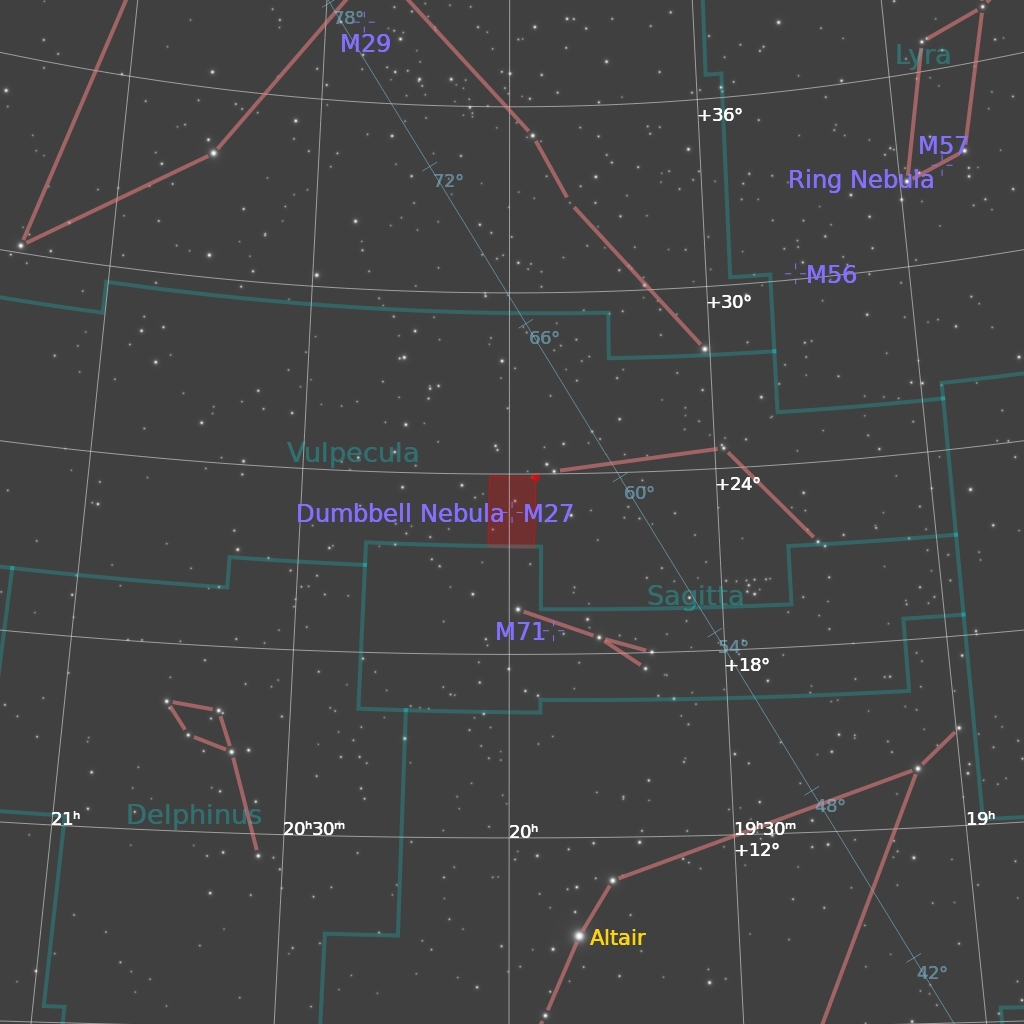Discovered by Charles Messier in 1764.
The Dumbbell Nebula Messier 27 (M27, NGC 6853) is perhaps the finest planetary nebula in the sky, and was the first planetary nebula ever discovered.
On July 12, 1764, Charles Messier discovered this new and fascinating class of objects, and describes this one as an oval nebula without stars. The name "Dumb-bell" goes back to the description by John Herschel, who also compared it to a "double-headed shot."
We happen to see this one approximately from its equatorial plane (approx. left-to-right in our image); this is similar to our view of another, fainter Messier planetary nebula, M76, which is called the Little Dumbbell. From near one pole, it would probably have the shape of a ring, and perhaps look like we view the Ring Nebula M57.
This planetary nebula is certainly the most impressive object of its kind in the sky, as the angular diameter of the luminous body is nearly 6 arc minutes, with a faint halo extensing out to over 15', half the apparent diameter of the Moon (Millikan 1974). It is also among the brightest, being at most little less luminous with its estimated apparent visual magnitude 7.4 than the brightest, the Helix Nebula NGC 7293 in Aquarius, with 7.3, which however has a much lower surface brightness because of its larger extension (estimates from Stephen Hynes); it is a bit unusual that this planetary is only little fainter photographically (mag 7.6). The present author (hf) was surprized how fine this object was seen in his 10x50 binoculars under moderately good conditions !
As measured by Soviet astronomer O.N. Chudowitchera from Pulkowo (and mentioned by L.H. Aller, Glyn Jones and Vehrenberg), the bright portion of the nebula is apparently expanding at a rate of 6.8 arc seconds per century, leading to an estimated age of 3,000 to 4,000 years, i.e. the shell ejection probably would have been observable this time ago (it actually happened earlier as the light had to travel all the distance of perhaps about 1000 light years). She estimated the distance somewhat short at only about 490 ly. Another estimate, given by Burnham, has obtained a rate 1.0 arc seconds per century, and an estimated age of 48,000 years.
The central star of M27 is quite bright at mag 13.5, and an extremely hot blueish subdwarf dwarf at about 85,000 K (so the spectral type is given as O7 in the Sky Catalog 2000). K.M. Cudworth of the Yerkes Observatory found that it probably has a faint (mag 17) yellow companion at 6.5" in position angle 214 deg (Burnham).
As for most planetary nebulae, the distance of M27 (and thus true dimension and intrinsic luminosity) is not very well known. Hynes gives about 800, Kenneth Glyn Jones 975, Mallas/Kreimer 1250 light years, while other existing estimates reach from 490 to 3500 light years. Currently, investigations with the Hubble Space Telescope are under work to determine a more reliable and acurate value for the distance of the Dumbbell Nebula.
Adopting our value of 1200 light years, the intrinsic luminosity of the gaseous nebula is about 100 times that of the Sun (about -0.5 Mag absolute) while the star is at about +6 (1/3 of the Sun) and the companion at +9..9.5 (nearly 100 times fainter than the Sun), all in the visual light part of the electromagnetic spectrum. That the nebula is so much brighter than the star shows that the star emits primarily highly energetic radiation of the non-visible part of the electro-magnetic spectrum, which is absorbed by exciting the nebula's gas, and re-emitted by the nebula, at last to a good part in the visible light. Actually, as for almost all planetary nebulae, most of the visible light is even emitted in one spectral line only, in the green light at 5007 Angstrom !
Image Session Details
-Location: 50.23°N, 8.46°E
-Target: M27 (NGC 6853) – Dumbbell Nebula
-Integration: 8h 21m
-Camera: Nikon D3500 (APS-C DSLR) – ISO 400
-Telescope: Askar 103 APO + 0.8× reducer (576 mm)
-Mount: Bresser Exos-2 + OnStep
-Control: ASIAIR Mini
-Guiding: SVBONY SV165 + ASI120MM Mini
-Sky Quality: Bortle 4, SQM ~20.8
-Moon Phase: Waning Crescent (~25%)
-Filter: None (stock DSLR)
-Date: 19–22 June 2025
-Object Type: Planetary Nebula
-Constellation: Vulpecula
-Apparent Size: ~8′ × 5′ (bright core), outer halo up to ~15′
-Distance: ~1,360 light years
General Properties
Type: Planetary nebula, class PN G060.8–03.6 (bipolar)
Coordinates: 19h 59m 36.34s, +22° 43′ 16.1″ (J2000)
Apparent Magnitude: 7.5 (V)
Angular Size: ~8′ × 5.7′ (bright core); ~15′ × 12′ including faint outer halo
Distance: ~410 pc (1,340 ly)
Constellation: Vulpecula
Discovery: Discovered by Charles Messier in 1764
Scientific Databases
[ POSITION ]
RA: 299.901513°
Dec: +22.721198°
Parallax: 2.570 mas
Proper motion: pmRA=10.52 mas/yr, pmDEC=3.70 mas/yr
Redshift: -0.00014
Radial velocity: -42.0 km/s
[ PHOTOMETRY ]
Catalog: V=14.09, G=14.04, B=13.75
V: 14.09
B: 13.75
B–V: -0.34
Hubble type (from color): Irr
IRAS 12 µm: 0.45 Jy
IRAS 25 µm: 3.13 Jy
IRAS 60 µm: 19.80 Jy
IRAS 100 µm: 58.40 Jy
1.4 GHz flux: 0.29 Jy
[ DISTANCE ]
1103.67 pc (3.60 kly, Gaia proxy (median bright-star parallax))
[ ALIASES ]
Diabolo Nebula, Dumbbell Nebula, 2MASX J19593637+2243157, IRAS 19574+2234, M 27, NGC 6853
-NED
Observation Notes
-Photographic Magnitude: 7.4
